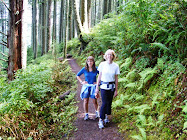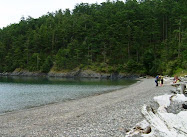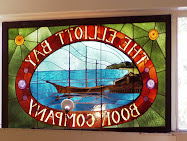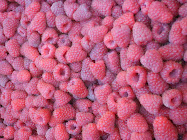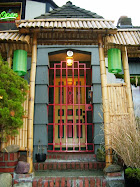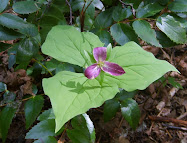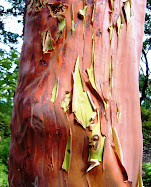 Although this post is originally from 2011, as of September 2018 I've updated some links and restaurant recommendations and added a few more suggestions.
Although this post is originally from 2011, as of September 2018 I've updated some links and restaurant recommendations and added a few more suggestions.I just read an article in Bon Appétit magazine about exotic Thanksgiving escapes to places like Buenos Aires, Argentina, and Toulouse in southern France. Really? I wondered if the author enjoyed negotiating busy airports that weekend.
While I’ve battled the airport crowds on T-day weekend trips to New York City and San Francisco, my favorite holiday getaways have been exploring here in the Pacific Northwest. Here are a few trips I’ve done that might inspire you, too.
Long Beach Peninsula, Washington
Late November is the stormiest, wettest time of the year in the Northwest, and the coast gets the brunt of the storm fronts. How about heading there for the real action?
Where to Stay - I spent a relaxing Thanksgiving weekend at the cozy Shelburne Inn in Seaview close to the ocean in southwest Washington. The Shelburne is the oldest continuously operating hotel in the State of Washington (since 1896) and a great launching point for exploring the peninsula’s beaches, cranberry bogs, historic small towns (like quaint Oysterville), or just reading a good book in your room.
 |
| Leadbetter Point State Park |
What to Do - We headed south along the coast to the Lewis and Clark National Historic Park (where we got some of the miserable weather that drove Meriwether Lewis into what was likely deep seasonal affective disorder) and another day drove up the peninsula to Leadbetter Point State Park. If you’re feeling adventurous and have good rain gear, take your sea kayak and paddle out to Long Island in lovely Willapa Bay, where I spent one of the wettest nights camping in my life. Fabulous birding in this part of the region.
Where to Eat - We had incredible meals while staying at the Shelburne Inn in the former Shoalwater Restaurant, but the owners have moved and opened the Bridgewater Bistro in Astoria that looks worth a trip down from Seaview. However, the new restaurant there, Shelburne Restaurant and Pub, looks excellent, with a focus on local, seasonal fare.
[In June 2018 I spent a weekend on the peninsula, which you can read about here.]
[In June 2018 I spent a weekend on the peninsula, which you can read about here.]
Mount Hood, Hood River, Columbia Gorge, Oregon
If you’ve read my blog, you know I love the Columbia River Gorge, Mount Hood, and northern Oregon along the Cascade Crest.
Where to Stay - We started the weekend staying at quirky and boisterous McMenamin’s Edgefield in Troutdale after Thanksgiving dinner with family, then drove up to Timberline Lodge on Mount Hood the next day for an overnight. Our third night was at the historic Hood River Hotel after a nice drive around the mountain and down through Hood River Valley.
 |
| View of Mt. Hood summit from Timberline, Magic Mile chairlift visible. |
What to Do - If there’s skiing anywhere in the Cascades in the early season, it’s at Timberline. I got in my first turns of the season and then thoroughly relaxed that evening in front of the massive stone fireplace in the beautiful old lodge. The next night in Hood River we wandered across the street from our hotel to the Skylight Theater Pub (where they also serve good pizza) for a movie.
Enroute back to Seattle we drove across the Columbia River and explored the Washington side of the Gorge, with a side trip up to really historic and very rustic Carson Hot Springs. Their spa offers massages and mineral baths in old claw foot tubs with water pumped in from the river raging outside the windows. Rumor has it that the place is haunted. [They have added some new buildings and spiffed up the place since I was there, so probably not as off the beaten path or rustic anymore.]
Where to Eat - Dinner in Timberline Lodge’s Cascade Dining Room was fabulous—I had savory fresh papardelle pasta with mushrooms, then a nightcap in the Ram’s Head Bar on the balcony overlooking the fireplace. We also had an excellent dinner in the lobby restaurant at the Hood River Hotel. Just a few months ago I dined at Celilo Restaurant and Bar in Hood River within a block or two of the hotel, wonderful!
 |
| Warming up by the fire, Timberline Lodge |
San Juan Islands, Washington
Any time of year is a good time to head to the lovely San Juans, but the islands are less crowded in the late fall and winter.
Any time of year is a good time to head to the lovely San Juans, but the islands are less crowded in the late fall and winter.
Where to Stay – Rustic Doe Bay Resort on Orcas Island is always fun. In Friday Harbor on San Juan Island we stayed at the Argyle House Bed & Breakfast, a comfy refurbished craftsman-style home just a couple blocks from downtown and easy walking to restaurants. New owners have taken over the place since we were there, but it looks as lovely as ever. I also spent a couple nights a few months ago at the earthbox inn in Friday Harbor. Clean, recently renovated, and great location for walking to town.
 |
| View from road up Mt. Constitution, Orcas Island |
What to Do - Winter is a great time to hike in Moran State Park. Drive up Mount Constitution in Moran State Park on Orcas Island for great views (or not, depending on the weather). When I was there on a T-Day weekend, a big raven greeted us at the misty summit. Or take your sea kayak and cruise the island rocky shorelines studded with starfish. The next day we took an interisland ferry over to San Juan Island, where we hiked and explored along the west side of the island at Lime Kiln State Park. This park is one of the best places to spot orca whales from the land.
Where to Eat - In Eastsound on Orcas Island, cozy Hogstones Wood Oven has some of the best wood-fired pizza I've ever tasted. Their motto is "Reverence for Excellence." I've also eaten recently at the Doe Bay Cafe, now transformed into a foodie's heaven with their mostly vegetarian but locally sourced, seasonal gourmet fare.
 |
| Dinner at Doe Bay Cafe is exquisite. |
Mount Rainier National Park
Late November usually brings heavy snow to the Cascades, and Mount Rainier gets some of the heaviest snowfall on the planet. Head to the mountain with your cross-country or back country skis.
Where to Stay – We stayed at the National Park Inn at the Longmire Historic District, lower down the mountain than more famous Paradise Inn. Open year-round, historic Longmire is casual and low-key but comfortable, and a great place to unwind in the evenings.
Late November usually brings heavy snow to the Cascades, and Mount Rainier gets some of the heaviest snowfall on the planet. Head to the mountain with your cross-country or back country skis.
 |
| Mt. Rainier from above Paradise |
What to Do - If there's enough snow on the ground – cross-country or backcountry ski up around Paradise. If there's not much of a snowpack yet – hike, there are plenty of trails around Longmire or higher up.
Where to Eat – In the park this late in the year the options are limited. Longmire Inn has a decent dining room, where we had some good meals. They also serve a traditional American Thanksgiving buffet there. Click here for reservation info.
 |
| Snowy Paradise Lodge |
More Ideas
Lake Quinault Lodge on the southwestern edge of Olympic National Park, splendid old-style lodge and setting, plus good walks through old growth forest nearby to burn off the turkey and stuffing. Or go to equally historic Lake Crescent Lodge on the northern edge of the park, where you'll find the same ambiance and forest walks.
 |
| Frosty winter morning at Lake Quinault Lodge |
 |
| Relaxing on the porch at Lake Crescent Lodge. |
Sun Mountain Lodge in the Methow Valley of north-central Washington is also a great destination. The views don't get much better and most years you can cross-country ski too. Talk about burning calories!
And for you vegetarians/flexitarians who really want to get away, try Breitenbush Hot Springs in Oregon's central Cascades, where they serve a vegetarian buffet. Soak and enjoy their usual Daily Well Being programs.
Okay, that's just scratching the surface of all the places to go. Do you have a favorite Thanksgiving weekend destination? Jump in the conversation by leaving a comment below!
























































